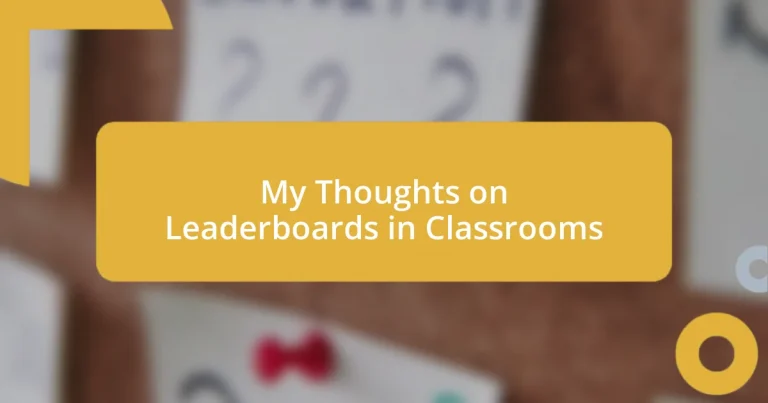Key takeaways:
- Leaderboards can motivate students through competition but may create stress and feelings of inadequacy for those who struggle.
- Implementing best practices, such as celebrating diverse achievements and providing clear criteria, helps create an inclusive learning environment.
- Alternatives to traditional leaderboards, like badges and team challenges, foster cooperation and self-reflection, emphasizing personal growth over rankings.
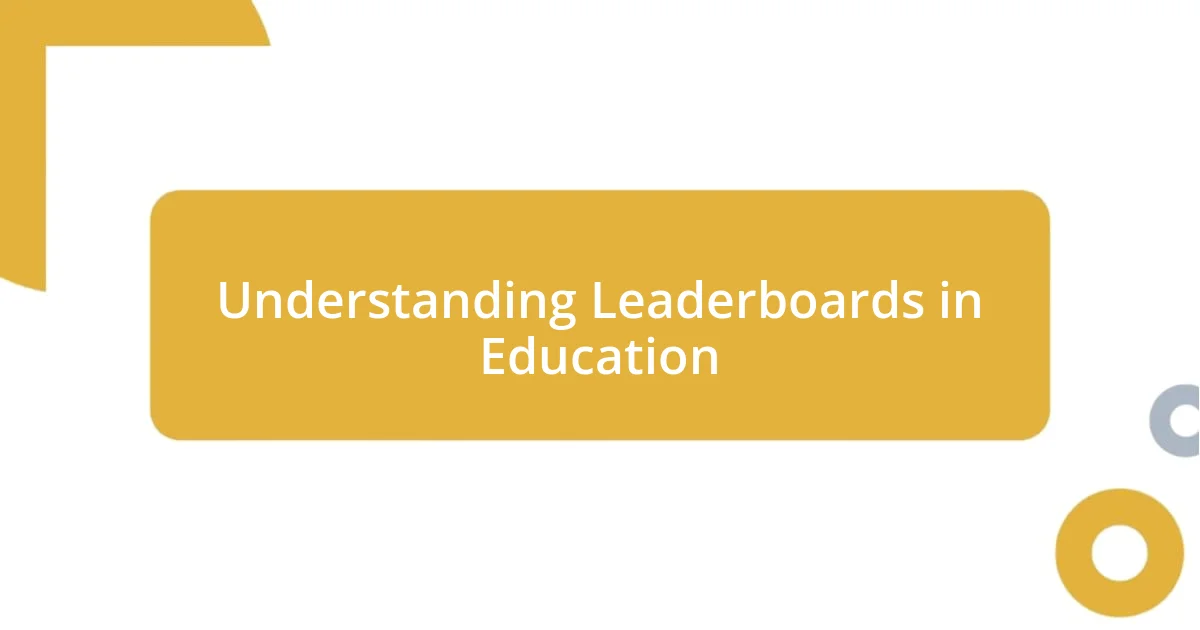
Understanding Leaderboards in Education
Leaderboards in education serve as a visual representation of student performance, motivating learners through competition and recognition. I remember seeing a leaderboard in my own classroom, where students anxiously scanned it for their names each week. Was I happy to see my name placed at the top? Absolutely. But what about those who weren’t as fortunate?
These scoreboards can foster a sense of community and drive, but they can also create stress for some students. I vividly recall a friend who often struggled with math; the pressure of being on a leaderboard made her feel inadequate and less capable, despite her hard work. It raises an important question: should we prioritize motivation through competition, or should we focus on individual growth and mastery instead?
Some educators argue that leaderboards can help harness motivation for everyone, but I’ve seen mixed results in practice. For instance, a teacher I knew transformed her classroom environment by switching from a ranking system to showing progress over time. The students celebrated personal milestones rather than just competing against each other. What a difference that made!
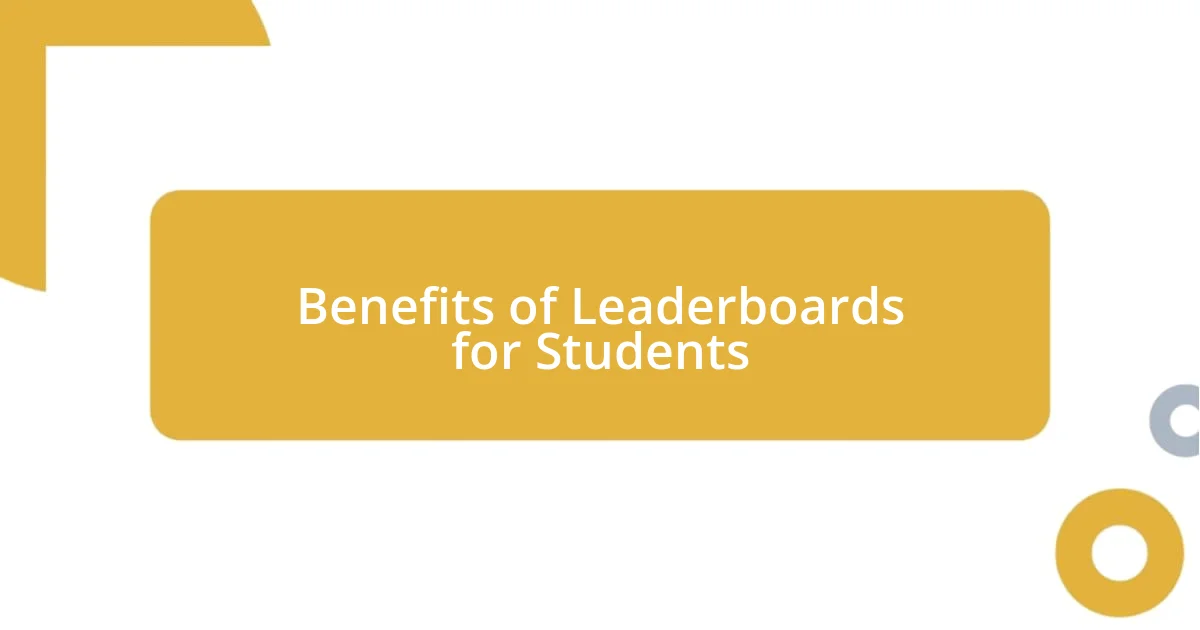
Benefits of Leaderboards for Students
In my experience, one of the major benefits of using leaderboards in classrooms is the sense of achievement they can inspire in students. I remember the excitement in the room during a math game where students could see their progress visually. This immediate recognition made them eager to improve, igniting a friendly competition that drove performance.
Here are some of the key benefits of leaderboards for students:
– Motivation: Visual rankings can push students to strive for improvement, often leading to greater effort and engagement.
– Goal-setting: They encourage students to set and pursue personal academic goals.
– Accountability: Leaderboards foster a sense of responsibility to not only themselves but also their peers.
– Community building: They create opportunities for collaboration and camaraderie as classmates cheer each other on.
– Recognition: Receiving acknowledgment can boost a student’s confidence and self-worth, especially when they see their name featured prominently.
On the other hand, I’ve also noticed that the right mindset about competition can make a huge difference. I recall a time when a leaderboard highlighted not just the top performers but also showcased students who improved the most. This approach turned what could have been a discouraging experience for some into a celebration of everyone’s progress. It’s all about striking that balance!
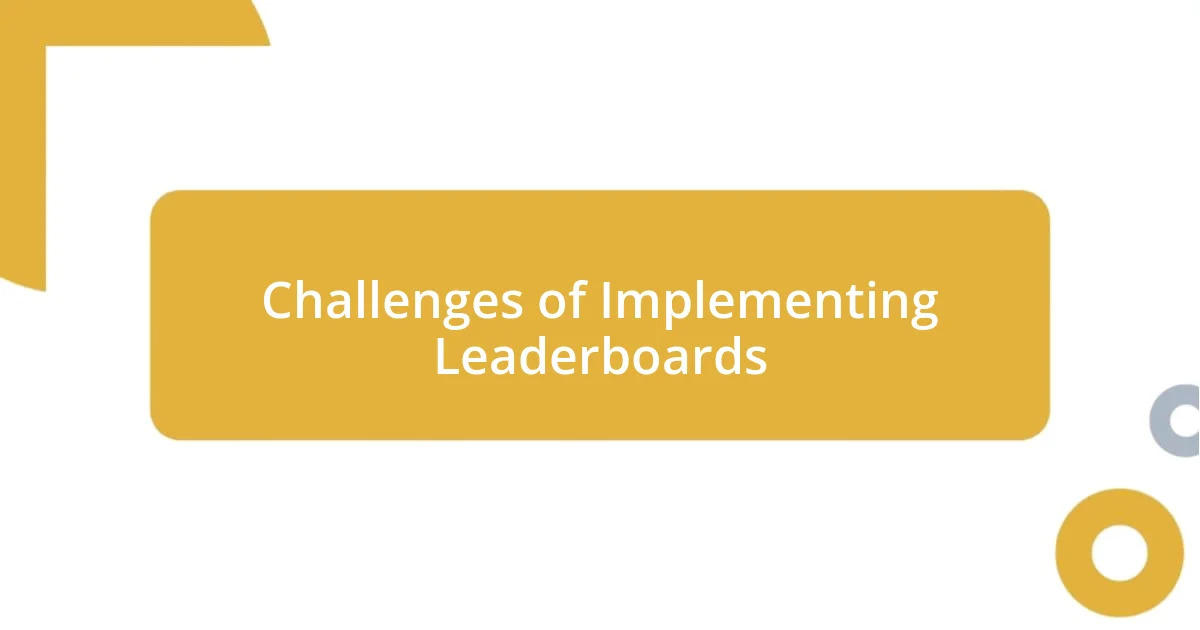
Challenges of Implementing Leaderboards
Implementing leaderboards in classrooms is not without its difficulties. One significant challenge I’ve observed is the potential for fostering unhealthy competition among students. I recall a particularly competitive classroom where one student, despite their best efforts, always found themselves at the bottom of the rankings. This situation not only impacted their academic performance but also their confidence, leading them to disengage from classroom activities altogether. It’s a stark reminder that while competition can be a powerful motivator, it can also be demoralizing for those who struggle to keep up.
In another instance, I saw how leaderboards could inadvertently cause distractions. One teacher incorporated a digital leaderboard which, though visually appealing, often diverted students’ focus from actual learning. Instead of concentrating on mastering the material, students became preoccupied with their standings, losing sight of their educational goals. Balancing the motivational aspects of leaderboards with the maintenance of a positive learning environment proves to be quite the tightrope walk.
Additionally, there’s the risk of excluding quieter students or those who excel in areas not represented on the leaderboard. I remember a shy girl in my class who excelled in writing but felt invisible amid the math scores that dominated the leaderboard. Her talents went unrecognized because they weren’t measured by the same metrics as her peers. Implementing leaderboards without considering the diverse strengths and challenges of all students can lead to feelings of alienation, rather than fostering an inclusive atmosphere.
| Challenge | Potential Impact |
|---|---|
| Unhealthy Competition | Can demoralize lower-performing students, affecting confidence and engagement. |
| Distraction from Learning | May lead to a focus on rankings instead of actual skill mastery. |
| Exclusion of Diverse Strengths | Can result in neglecting students excelling in areas not reflected in the leaderboard. |
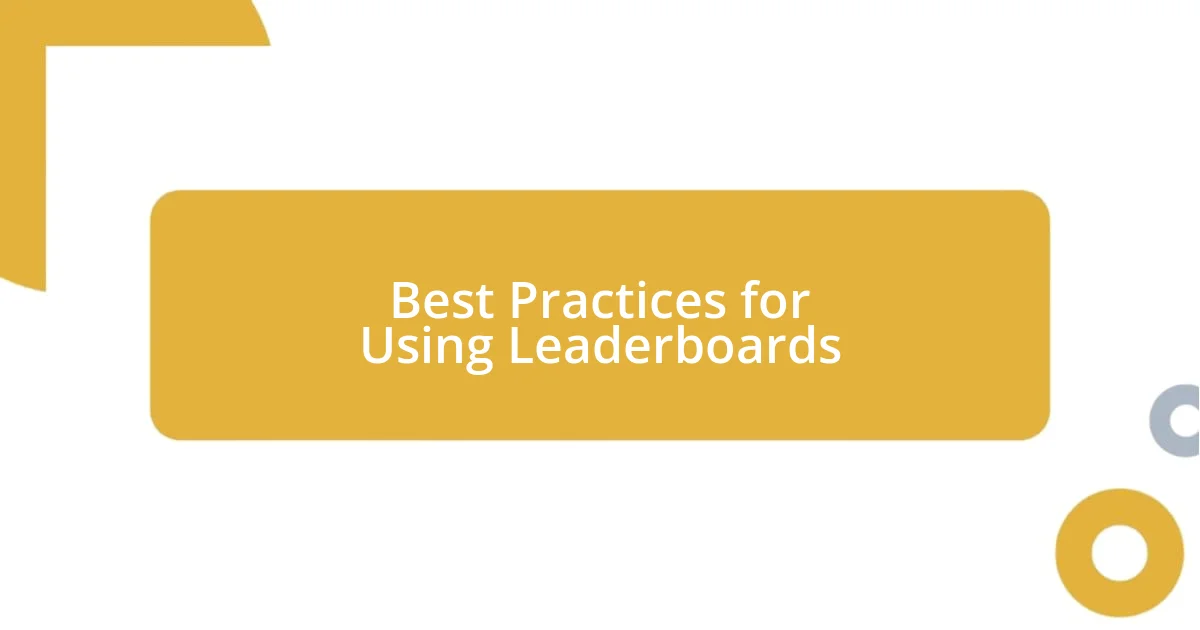
Best Practices for Using Leaderboards
When using leaderboards, I’ve found that clarity is key. Ensuring that students understand how the rankings are determined can significantly alleviate confusion and anxiety. For instance, I once explained the scoring system before a project, detailing what criteria would influence their standings. This transparency helped everyone feel more at ease and allowed them to focus on improving rather than stressing about how the leaderboard worked.
Another best practice is to celebrate diverse achievements. I vividly remember introducing a “most improved” section on our leaderboard. Instead of just ranking the top scorers, this change highlighted students who made significant strides in their learning. The joy on those students’ faces was incredible! It made me realize that fostering a culture of growth rather than just competition creates a more inclusive environment for everyone—doesn’t that sound like a better approach?
Lastly, I believe in the power of rotation. I’ve occasionally changed up how students were ranked based on different subjects or skills, such as teamwork, creativity, or improvement over time. This keeps the leaderboard dynamic and prevents it from becoming stale or discouraging for anyone. I often wondered, what if every student had the opportunity to shine in their unique way? Rotating criteria not only encourages collaboration but also promotes a sense of belonging among students, reminding them that there are many ways to succeed.
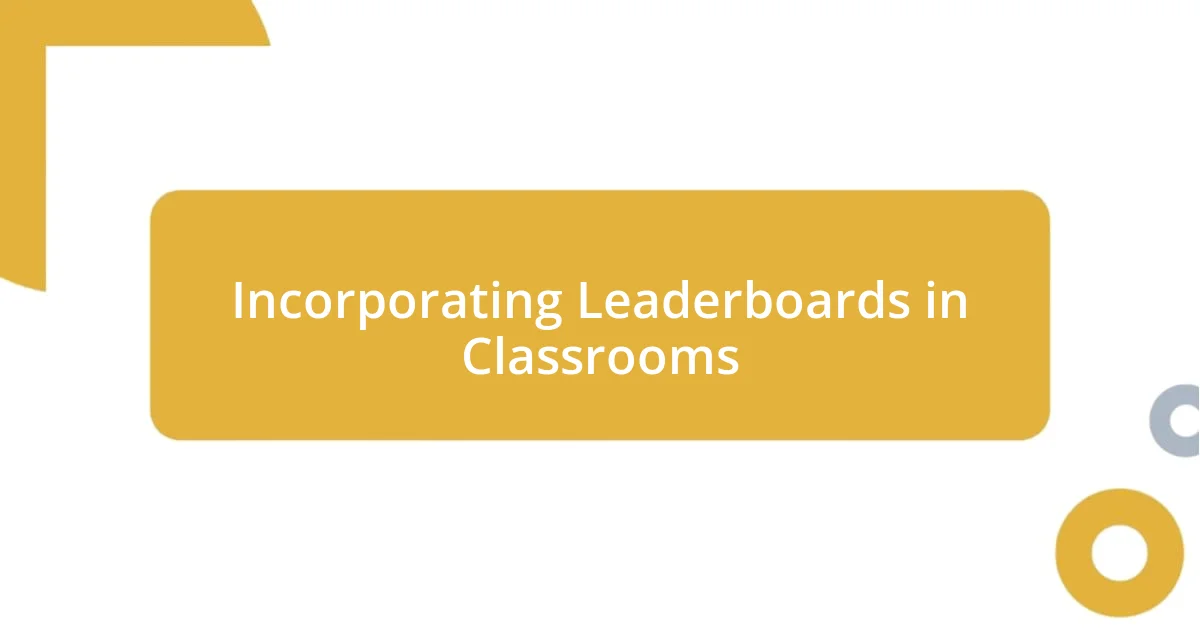
Incorporating Leaderboards in Classrooms
Incorporating leaderboards in classrooms can be approached creatively to enhance engagement. For instance, I once implemented a weekly leaderboard that not only tracked standard assessments but also participation and peer support. It was remarkable to see students rally around each other, celebrating not only personal achievements but also the growth of their classmates. Isn’t it fascinating how a shift in focus can transform a competitive atmosphere into a supportive community?
Another method I’ve tried is integrating themed leaderboards. One year, I created a “reading leaderboard” during a month-long literary challenge, where points were awarded not just for pages read but also for book recommendations and discussions. This approach sparked lively debates and exchanges among students, making it a shared joy rather than a pressure-cooker scenario. It made me think—how often do we overlook the collaborative potential of competition?
Finally, I find that pairing leaderboards with goal-setting activities fosters a deeper connection to learning. Before introducing the leaderboard, I encouraged students to define personal goals tailored to their strengths and limitations. After a few months, they would review their aspirations alongside their standings, allowing them to take ownership of their learning journey. By intertwining individual objectives with shared achievements, I noticed a significant increase in motivation. Wouldn’t it be great if every student learned to navigate competition in a way that reflects their personal growth?
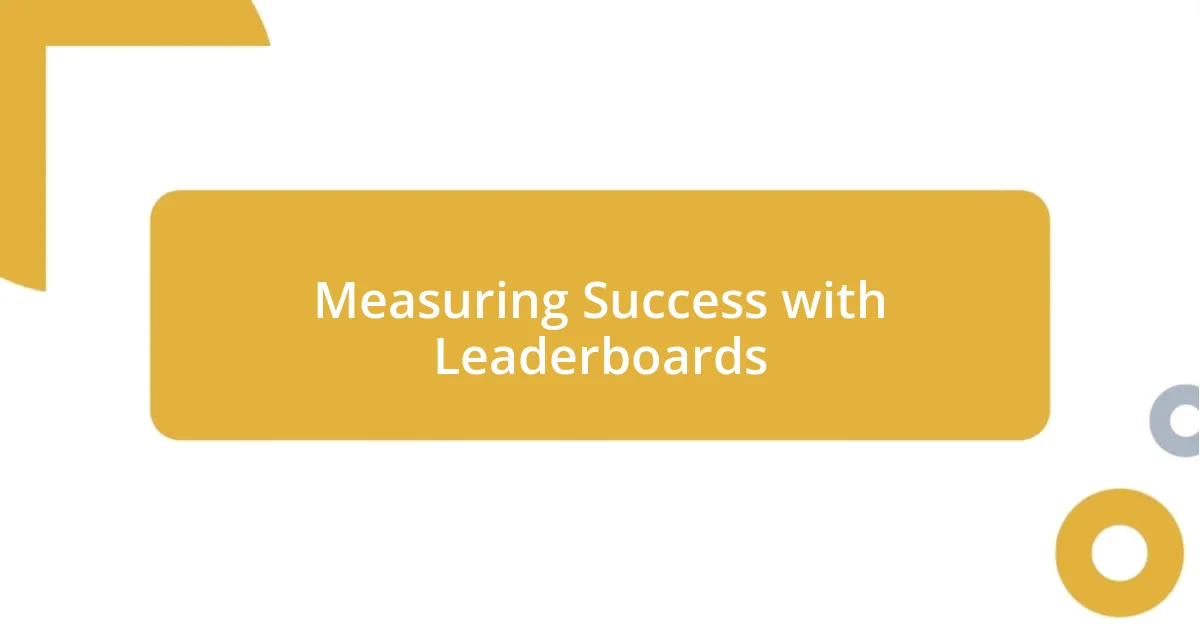
Measuring Success with Leaderboards
In my experience, leaderboards provide an excellent framework for measuring success, especially when they are tailored to reflect multiple dimensions of student achievement. For example, I remember a class where I implemented a leaderboard that recognized academic accomplishments alongside qualities like kindness and teamwork. The energy shifted dramatically as students began to strive not only for academic excellence but also for being supportive classmates. It forced me to wonder—how often are we measuring success holistically in education?
Another aspect of measuring success with leaderboards that I’ve found effective is using them to set not only competitive goals but also personal benchmarks. One semester, I encouraged students to track their progress in specific skills like problem-solving or creative thinking. As they saw their improvements visually represented, their excitement was palpable. I realized that their faces lit up at the recognition of their hard work—wasn’t that a powerful moment of validation for them?
Finally, I can’t stress enough how contextualizing leaderboard rankings can enhance their effectiveness. I distinctly recall one student, who was usually quiet, blooming when her work on a group project earned her a top spot for collaboration. She beamed with pride, and it struck me then—success on a leaderboard doesn’t just elevate scores; it can illuminate hidden talents. Doesn’t it make you think about the potential for every student to shine when we measure success in varied, meaningful ways?
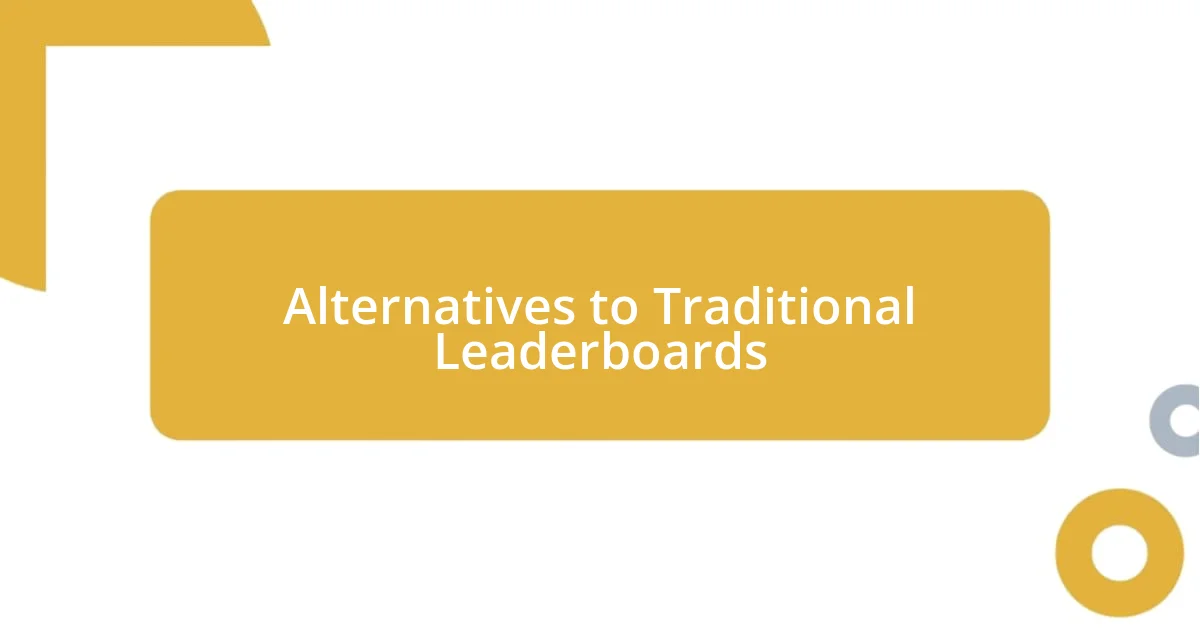
Alternatives to Traditional Leaderboards
In my journey as an educator, I’ve discovered that moving away from traditional leaderboards can yield some truly enriching alternatives. One strategy I’ve implemented is using badges or stars to celebrate specific achievements rather than ranking students. I recall a student who struggled with his confidence; when he received a badge for “most improved participation,” it was like watching a light bulb turn on. It made me ponder how we can often underestimate the power of small recognitions in fostering self-esteem.
Another engaging alternative involves collaborative team challenges where students work together towards shared goals, rather than individually competing for a top spot. I facilitated a science project where teams were awarded points for creative solutions instead of compared directly against each other. The result? A vibrant atmosphere of cooperation! Students were not only eager to tackle challenges but also actively supported each other. Isn’t it interesting to think that a little teamwork can transform the classroom dynamic so positively?
Lastly, I’ve found that incorporating self-reflection sessions adds a powerful layer to the learning experience. After a project, I would spend time discussing what worked well and what could be improved, inviting each student to share their own insights. I’ll never forget a student who, after reflecting on his project, expressed that even though he didn’t score the highest, the knowledge he gained mattered more to him. It made me reflect: what if we shifted our focus from mere rankings to nurturing a deeper understanding of personal growth and learning?












